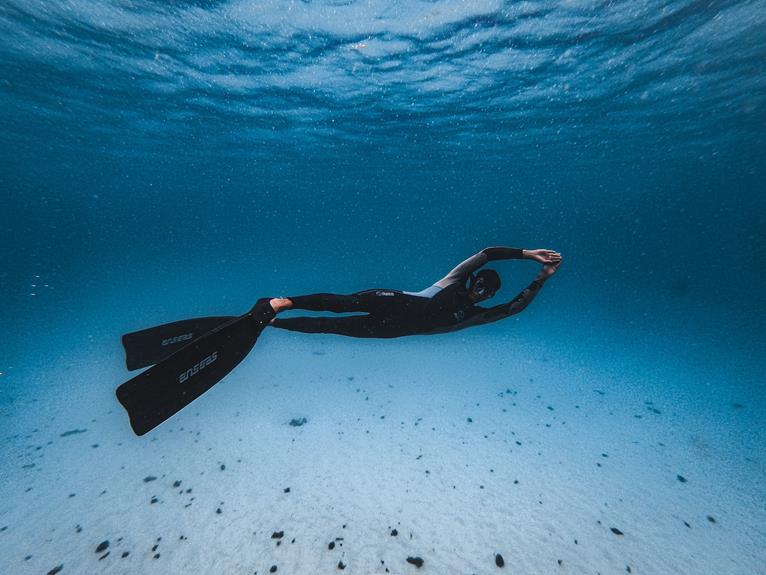Are you ready to dive into the world of scuba with the perfect pair of diving fins? Well, buckle up because we've got everything you need to know right here.
From finding the ideal fit to caring for your fins, we'll be your underwater guide.
So get ready to make a splash and discover the ins and outs of diving fins for scuba.
Let's dive in together and explore the depths of this essential scuba gear!
Key Takeaways
- Proper fit enhances the diving experience
- Sizing fins is similar to sizing shoes
- Rinse fins thoroughly with fresh water after each dive
- Store fins in a cool, dry place to avoid warping
Proper Fit for Optimal Diving Experience
Ensuring a proper fit is essential for optimizing your diving experience. When choosing the right fin material, consider factors such as flexibility, durability, and weight. Different diving conditions require different fin sizes.
For open heel fins, try them on with booties to ensure a proper fit. Men should typically start with the same fin size as their shoes, while women usually go one size smaller.
Full foot dive fins should fit snugly without any struggle to put them on. To ensure a secure fit, perform the shake test and make sure there's no rubbing or pinching.
Remember to rinse your fins thoroughly with fresh water after each dive and allow them to dry completely before storing. Store them in a cool, dry place to avoid warping and avoid storing them on their tips to prevent distortion.
Sizing and Care Tips for Diving Fins
To properly size and care for your diving fins, follow these tips for optimal performance and longevity:
- Common misconceptions about diving fin sizing: It isn't always necessary to go one size smaller for women; it depends on the individual's foot shape and comfort level.
- The impact of fin design on diving performance: Different fin designs, such as split fins or paddle fins, can affect propulsion and maneuverability underwater.
- Rinse fins thoroughly with fresh water after each dive to remove salt and debris that can cause corrosion.
- Allow fins to dry completely before storing to prevent the growth of mold and bacteria.
- Store fins in a cool, dry place to avoid warping and damage.
How to Choose the Right Fin Straps
Choose fin straps that are durable and adjustable for a secure and comfortable fit while diving. The importance of proper fin strap tension cannot be overstated. It ensures that the fins stay securely in place on your feet, preventing them from slipping off or shifting during your dive. There are different types of fin strap materials, each with their own benefits. Neoprene straps are popular for their stretchiness and ability to conform to the shape of your feet. Silicone straps are known for their durability and resistance to wear and tear. Rubber straps offer a secure grip on your feet and are less likely to loosen during your dive. Nylon straps are lightweight and easy to adjust. Consider the material that best suits your needs and dive confidently with the right fin straps.
| Fin Strap Materials | Benefits |
|---|---|
| Neoprene | Stretchy and conforming |
| Silicone | Durable and resistant to wear |
| Rubber | Secure grip and less likely to loosen |
| Nylon | Lightweight and easy to adjust |
Latest Trends and Updates in Scuba Diving
To stay up-to-date with the latest trends and updates in scuba diving, it's important to keep exploring new diving fins and accessories. The world of scuba diving gear is constantly evolving, with advancements in technology and design that enhance the diving experience.
Here are some of the latest trends and updates in scuba diving:
- Lightweight and compact diving fins that provide improved maneuverability underwater.
- Innovative fin designs that maximize propulsion and minimize drag, allowing divers to conserve energy and swim efficiently.
- Diving fins with adjustable features, such as interchangeable blades or customizable foot pockets, for a personalized fit and enhanced comfort.
- Integration of technology into diving fins, such as built-in GPS or depth sensors, to enhance safety and navigation during underwater exploration.
- Diving fins designed specifically for underwater photography, with features like detachable camera mounts or improved stability for capturing stunning underwater images.
Essential Tips for Maintaining Diving Fins
Maintaining diving fins requires regular care and attention to ensure their longevity and optimal performance. To prevent fin distortion, it's crucial to rinse your fins thoroughly with fresh water after each dive. This helps remove salt, sand, and other debris that can cause damage over time.
After rinsing, allow your fins to dry completely before storing them in a cool, dry place to avoid warping. It's important to avoid storing fins on their tips, as this can lead to distortion. Additionally, prevent contact with oil, aerosol, and chemical solvents to avoid erosion or degradation.
Must-Have Accessories for Scuba Diving Fins
To enhance your diving experience and ensure optimal performance, consider investing in these must-have accessories for your scuba diving fins:
- Spring Straps: Enjoy the benefits of easy donning and doffing, as well as a secure fit that eliminates the risk of losing your fins underwater.
- Fin Keepers: Keep your fins securely attached to your boots, preventing accidental loss or damage.
- Fin Bags: Protect your fins during transportation and storage, preventing scratches and other damage.
- Fin Strain Relief: Reduce the strain on your ankles and feet by distributing the pressure evenly across the fin strap.
- Fin Blade Material: Choose the right material for your fin blades, such as fiberglass or carbon fiber, to optimize performance and durability.
Using spring straps with diving fins provides convenience and ensures a secure fit, while choosing the right fin blade material is crucial for achieving optimal performance and durability. Don't forget to invest in fin keepers, fin bags, and fin strain relief for added convenience and protection.
Frequently Asked Questions
Are There Different Types of Diving Fins Available for Scuba Diving?
Yes, there are different types of diving fins available for scuba diving. They come in different materials and blade styles, each offering unique advantages for propulsion and maneuverability underwater.
Can I Wear Diving Fins Without Booties?
You can wear diving fins without booties, but wearing booties with fins offers several benefits. Booties provide added comfort, protection, and warmth for your feet. However, using strapless diving fins can be a personal preference with pros and cons to consider.
How Often Should I Replace My Diving Fin Straps?
You should replace your diving fin straps if you notice signs of wear such as fraying, cracking, or difficulty adjusting. Regular maintenance is important to ensure the safety and functionality of your fins.
What Are the Benefits of Using Full Foot Dive Fins?
Full foot dive fins provide increased propulsion and maneuverability in the water, enhancing your scuba diving experience. The snug fit ensures comfort and prevents slipping, allowing you to focus on exploring the underwater world.
Are There Any Specific Techniques for Improving Buoyancy Control With Diving Fins?
To improve buoyancy control with diving fins, focus on proper fin selection and technique. Choose fins that fit snugly without struggle. Practice adjusting your body position and kicking techniques to achieve optimal buoyancy control.

